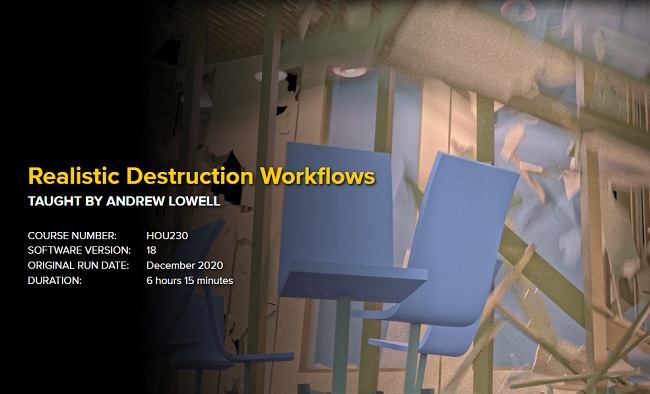HOU230 – Realistic Destruction Workflows
Release date:2020, December 24
Author:ANDREW LOWELL
Skill level:Beginner
Language:English
Exercise files:Yes
This course will guide you through the latest destruction processes and workflows using Houdini and Bullet. Technical methods as well as eye development come together in the course and you’ll be guided through the complete destruction process, producing a realistic final result.
Realistic destruction starts with reference and high quality, representative fractures. Constraints between rigid body objects should be varied and appropriate based on material type. Testing for realism can be performed prior to simulation and the simulation can be assessed both as a scientist as well as an animator. Post motion processing can final a tough destruction shot in days instead of weeks.
For many years Andrew has been recognized by industry as an FX TD and trainer.Movie creditsstudios include /Mummy 3, Aliens in the Attic, Invictus, Thor, Sucker Punch, Transformers 3, Jack the Giant Slayer, and Ender’s Game at studios Digital Domain, Rhythm and Hues, and Animal Logic.He’s conducted many seminars around the world and written articles, authored a Houdini book, and heads initiatives like the Houdini Music Toolset. He also conducts formal training at dedicated institutions such as Animation Workshop and fxphd.
course syllabus
CLASS 1: DESTRUCTION WORKFLOW OVERVIEW & CUSTOM FRACTURING
An overview of mentalities and workflows for large and complex destruction simulation. Using pre-made tools is good for a start, but custom fracturing is the key to getting a fast and reliable look from destruction. In this class, low level geometry processes will be used to create an incredibly efficient and direct-able fracture pattern.
CLASS 2: CONSTRAINT SETUP AND USES
Constraints are the life-blood of a destruction simulation. In this class, core constraint concepts and logic are applied to create highly specific constraint relationships.
CLASS 3: THE CONE-TWIST CONSTRAINT
The special needs of the rotational cone-twist constraint type are discussed in detail and applied in a simple test scenario.
CLASS 4: CONE-TWIST APPLICATION
The use and application of the cone-twist constraint type is clearly on display in a highly rotational and complex object: an office chair with wheels. Practice in applying this constraint type will aid in previously difficult simulations involving bending, breaking, or mechanical parts.
CLASS 5: DYNAMIC BENDING AND BREAKING
Constraint workflows are applied to create highly specialized and powerful relationships between rigid objects to mimic soft body technology for a blazing performance and stability improvement.
CLASS 6: SIMULATION MICRO-TESTING
The science and art of orchestrating larger destruction scenes is crafted through rigorous testing and organizational practices.
CLASS 7: GLOBAL CONSTRAINT RELATIONSHIPS
This class sets its sights wide and all encompassing with a move into larger constraint relationships between major objects and material types.
CLASS 8: SCULPTING SIMULATIONS WITH TRANSFORMS AND TIMING
The distortion of time and 3D space is a highly underused and powerful methodology when approaching rigid body simulations. Here a normally cumbersome and heavy simulation is broken into small and directable parts using time manipulation.
CLASS 9: TAKING CONTROL OF HEAVY SIMULATIONS
A heavy simulation often strikes fear into juniors and seniors alike and can lead to long iteration times and cumbersome workflows. In this class, you will see how a heavy simulation may be approached and navigated with speed and control.
CLASS 10: DYNAMIC SURFACING
The final phase of any destruction shot is producing a renderable result from low resolution or proxy objects. In this class, the art of surfacing with low level and highly efficient geometry operations is taught and demonstrated for changing topology as well as splintering effects.





 Channel
Channel





